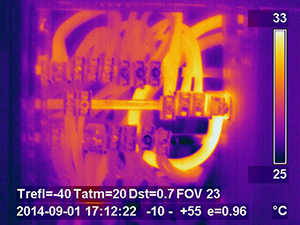Infrared Thermography for Detecting Electrical Faults in Live Systems
By far the single most common application for Thermal Imaging worldwide is the examination of electrical systems.
By definition there isn’t an electrical system in existence that is fail proof.
It can take the identification of one large electrical problem to pay for an extensive Thermal Imaging Survey.
Initially the systems will work fine with no apparent or visible problems, but as the system ages it becomes corroded either due to poor contact systems or general wear and tear. It is at these corroded areas where the current passing through the system encounters its highest resistance, which manifests itself as heat. Once the heat at these points is sufficient it will cause the system to fail. In order to carry out Thermal Imaging surveys there needs to be power in the system. If there is no power there is no resistance, if there is no resistance there is no thermal energy being created at the resistance points.
It is advisable to have any electrical systems or circuits to be operating at, at least, thirty per cent of the maximum load of the system or circuit. The higher the flow of power through the system the easier it will be to carry out any Thermal Imaging investigative work. Thermal Imaging is perfect for electrical inspections because it enables inspection of systems while they are in use. It is completely non-contact, so the danger of electrocution is greatly reduced. It is however paramount that the person operating the camera is a fully trained Thermographer and or electrician, often times if they specialise in electrical inspections they will also be electricians.
If they are not, it is essential that they have a qualified electrician with them throughout the survey, both for health and safety considerations and also to advise of circuit loads, capacities etc. Due to the fact that with electrical inspections very high voltages can be involved, electrical cabinets in modern facilities can often be found to have spy glass lenses in the doors that have been specifically designed to enable both Thermographers and other maintenance professionals to see the workings without opening the cabinets. It is advisable to anyone carrying out a Thermal Imaging inspection not to touch any part of the electrical system, without exception.


